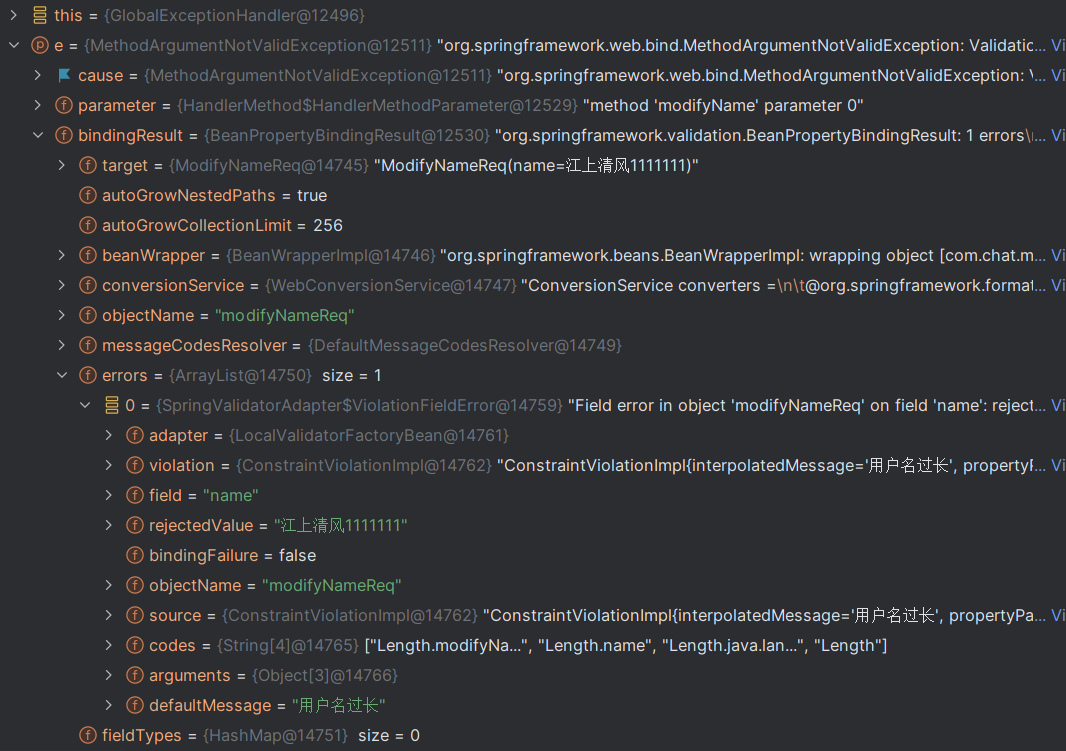线程池
众所周知,默认情况下,ThreadPoolTaskExecutor 中的线程在执行过程中如果出现未捕获的异常,异常信息不会自动输出到日志中,这会使得排查错误变得困难。为了增强对线程池中未捕获异常的处理,可以通过实现 Thread.UncaughtExceptionHandler 来捕获异常,并将异常日志记录下来
实现自定义异常处理器
自定义一个 UncaughtExceptionHandler,用于捕获并记录线程中的未捕获的异常:
1
2
3
4
5
6
7
| @Slf4j
public class MyUncaughtExceptionHandler implements Thread.UncaughtExceptionHandler {
@Override
public void uncaughtException(Thread t, Throwable e) {
log.error("Exception in thread" , e);
}
}
|
创建自定义的 ThreadFactory
在自定义的 ThreadFactory 中,将该异常处理机制应用到每个线程上:
1
2
3
4
5
6
7
8
9
10
11
12
| @AllArgsConstructor
public class MyThreadFactory implements ThreadFactory {
private static final MyUncaughtExceptionHandler MY_UNCAUGHT_EXCEPTION_HANDLER = new MyUncaughtExceptionHandler();
private ThreadFactory original;
@Override
public Thread newThread(Runnable r) {
Thread thread = original.newThread(r);
thread.setUncaughtExceptionHandler(MY_UNCAUGHT_EXCEPTION_HANDLER);
return thread;
}
}
|
在线程池中应用自定义的 ThreadFactory
将自定义的 MyThreadFacroty 设置进线程池配置中:
1
2
3
4
5
6
7
8
9
10
11
12
13
14
| @Bean(MALLCHAT_EXECUTOR)
@Primary
public ThreadPoolTaskExecutor mallchatExecutor() {
ThreadPoolTaskExecutor executor = new ThreadPoolTaskExecutor();
executor.setWaitForTasksToCompleteOnShutdown(true);
executor.setCorePoolSize(10);
executor.setMaxPoolSize(10);
executor.setQueueCapacity(200);
executor.setThreadNamePrefix("mallchat-executor-");
executor.setRejectedExecutionHandler(new ThreadPoolExecutor.CallerRunsPolicy());
executor.setThreadFactory(new MyThreadFactory(executor));
executor.initialize();
return executor;
}
|
测试捕获结果
使用以下代码进行测试:
1
2
3
4
5
6
7
8
9
10
11
12
13
14
| @Autowired
private ThreadPoolTaskExecutor threadPoolTaskExecutor;
@Test
public void thread1() throws InterruptedException {
Thread thread = new Thread( ()->{
if (1 == 1) {
log.error("1234");
throw new RuntimeException("1234");
}
});
thread.setUncaughtExceptionHandler(new MyUncaughtExceptionHandler());
thread.start();
Thread.sleep(200);
}
|
可以看到异常在log中的打印

对于项目中参数错误异常的捕获以及返回
Spring 框架中提供了对于传参的限制条件的注解,如 @NotBlank, @Length, @NotNull 等注解,非常利于开发。然而,这些注解的报错信息只会在 log 中打印,而不会返回给前端。以下是一个示例:
1
2
3
4
5
6
7
| @Data
public class ModifyNameReq {
@ApiModelProperty("用户名")
@NotBlank
@Length(max = 2, message = "用户名过长")
private String name;
}
|
当我传参为
1
2
3
| {
"name" : "江上清风1111111"
}
|
返回的结果:
1
2
3
4
5
6
| {
"timestamp": 1728992170171,
"status": 400,
"error": "Bad Request",
"path": "/capi/user/name"
}
|
而错误信息只是在系统日志中进行打印
1
| 2024-10-15 19:36:10.159 WARN 40880 --- [nio-8080-exec-1] .w.s.m.s.DefaultHandlerExceptionResolver : Resolved [org.springframework.web.bind.MethodArgumentNotValidException: Validation failed for argument [0] in public com.chat.mallchat.common.common.domain.vo.resp.ApiResult<java.lang.Void> com.chat.mallchat.common.user.controller.UserController.modifyName(com.chat.mallchat.common.user.domain.vo.req.ModifyNameReq) with 2 errors: [Field error in object 'modifyNameReq' on field 'name': rejected value [江上清风1111111]; codes [Length.modifyNameReq.name,Length.name,Length.java.lang.String,Length]; arguments [org.springframework.context.support.DefaultMessageSourceResolvable: codes [modifyNameReq.name,name]; arguments []; default message [name],2,0]; default message [用户名过长]] [Field error in object 'modifyNameReq' on field 'id': rejected value [null]; codes [NotNull.modifyNameReq.id,NotNull.id,NotNull.java.lang.Long,NotNull]; arguments [org.springframework.context.support.DefaultMessageSourceResolvable: codes [modifyNameReq.id,id]; arguments []; default message [id]]; default message [别忘记传id]] ]
|
因此,我们需要捕获抛出的异常中的错误信息,并利用自定义的 ApiResult 前后端交互协议进行返回。
捕获异常
在 log 中可以看到抛出异常的类

新建一个异常捕获的处理类, 其中
@RestControllerAdvice 用于标记 GlobalExceptionHandler 类为全局异常处理类,专门处理 REST 控制器中的异常,并以 JSON 格式返回响应;@ExceptionHandler 注解用于指定捕获特定类型的异常1
2
3
4
5
6
7
8
9
10
11
12
13
| @RestControllerAdvice
@Slf4j
public class GlobalExceptionHandler {
@ExceptionHandler(value = MethodArgumentNotValidException.class)
public ApiResult<?> methodArgumentNotValidException(MethodArgumentNotValidException e) {
System.out.println();
return ApiResult.fail(null, null);
}
}
|
查看异常数据
进行断点查看抛出异常时的数据:

可以看到, 异常的信息在 bindingResult 下的 errors 中, 其中 field 时发生错误的字段, defaultMessage 是在 vo类 中设置的错误信息.
在 Handler类 中对这些信息进行处理。其中, 不同属性的报错以逗号隔开:
1
2
3
4
5
6
7
| @ExceptionHandler(value = MethodArgumentNotValidException.class)
public ApiResult<?> methodArgumentNotValidException(MethodArgumentNotValidException e) {
StringBuilder errorMsg = new StringBuilder();
e.getBindingResult().getFieldErrors().forEach(x -> errorMsg.append(x.getField()).append(x.getDefaultMessage()).append(","));
String message = errorMsg.toString();
return ApiResult.fail(CommonErrorEnum.PARAM_INVALID.getCode(), message.substring(0, message.length() - 1));
}
|
接口返回结果
1
2
3
4
5
6
| {
"success": false,
"errCode": -2,
"errMsg": "name用户名过长",
"data": null
}
|
可以看到在 errMsg 中有处理过的信息了
对系统内部异常的拦截
捕获异常并处理
当系统发生错误时,如果直接将详细的错误信息返回给前端(堆栈跟踪、异常类型等),可能会暴露内部实现细节或敏感数据,给潜在的攻击者提供利用漏洞的机会。因此,通过全局异常拦截,只返回固定的错误信息,如 “系统出错,请稍后再试”,可以有效地避免暴露内部信息,提升系统的安全性。
与上面对于 参数异常捕获 的方式一样, 不同的是只需要设置一个固定的返回信息就行。
对于 Throwable.class 的处理类
1
2
3
4
5
6
7
8
9
|
@ExceptionHandler(value = Throwable.class)
public ApiResult<?> throwable(Throwable e) {
log.error("system exception! the reason is: {}", e.getMessage(), e);
return ApiResult.fail(CommonErrorEnum.SYSTEM_ERROR);
}
|
编写测试接口
1
2
3
4
5
6
7
| @GetMapping("/test")
public ApiResult<UserInfoResp> getUserInfo() {
if (1 == 1) {
int i = 1/0;
}
return ApiResult.success()
}
|
测试捕获以及接口返回结果
接口测试:
1
2
3
4
5
6
| {
"success": false,
"errCode": -1,
"errMsg": "系统出小差了, 请稍后再试哦~~",
"data": null
}
|
系统日志:




